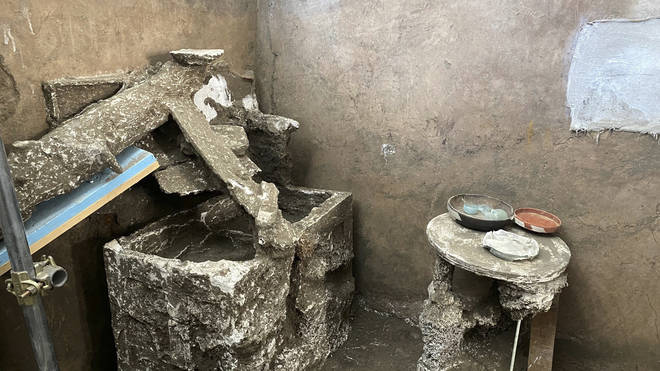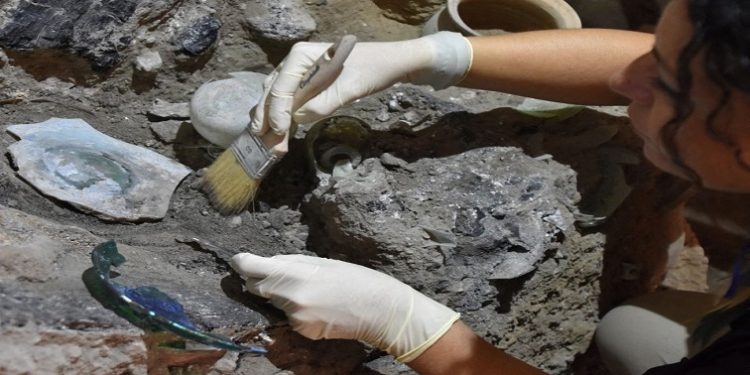Pompeii discoveries shed light on middle class life
Archaeologists have discovered four new rooms in a house in Pompeii filled with plates, amphoras and other everyday objects, giving a snapshot of middle class life at the moment Mount Vesuvius’s eruption buried the Roman city in AD 79.
The remains of bowls, a hastily emptied trunk, a bed and a crib-shaped terra-cotta perfume burner were found on two floors of a previously-excavated building, the Pompeii archaeological park authority said on Saturday.
Some were more valuable than others – vessels made of bronze or glass next to everyday tools.
“A large slice of the population in the Roman Empire were people who sweated for their daily bread but were also anxious to raise their social status,” the park’s director, Gabriel Zuchtriegel, said.
Archaeologists took plaster casts to reproduce some of the objects from the site in Pompeii, one of Italy’s main tourist attractions near the modern city of Naples.
The rest of the structure, excavated in 2018, includes a courtyard decorated in frescoes of plants, birds and hunting scenes. A niche hosting the household guardian gods, or Lares, gave the “Larario house” its popular name.
“The owners of the Larario house in Pompeii had been able to decorate the courtyard hosting the Lares site and a well with outstanding paintings, but evidently they didn’t have enough money for all of the rooms,” Zuchtriegel added.
“We don’t know who lived here but the pleasurable life depicted in the courtyard was probably more of an aspiration than their everyday reality.”
New Pompeii finds highlight middle-class life in doomed city
6 August 2022, 16:54

Three-legged tables topped by decorative bowls were among the latest finds.
Discoveries by archaeologists in Pompeii have enriched knowledge about middle-class households in the ancient Roman city that was destroyed in a volcanic eruption.
A trunk with its lid left open, a wooden dishware closet, its shelves caved in, and three-legged tables topped by decorative bowls are among the latest finds.
Pompeii’s archaeological park, one of Italy’s top tourist attractions, announced the recent finds.
Its director, Gabriel Zuchtriegel, said the excavation of rooms in a “domus”, or home, first unearthed in 2018 had revealed precious details about the domestic environment of ordinary citizens of the city, which was destroyed in 79AD following an eruption by Mount Vesuvius.

In past decades, excavations largely concentrated on sumptuous, elaborately frescoed villas of Pompeii’s upper-class residents.
But archaeology activity in the sprawling site, near modern-day Naples, has increasingly focused on the lives of the middle class as well as of servants and other enslaved people.
“In the Roman Empire, there was an ample chunk of the population that struggled with their social status and for whom ‘daily bread’ was anything but a given,” Mr Zuchtriegel said. ”A vulnerable class during political crises and food shortages, but also ambitious about climbing the social ladder.”
The finds unveiled on Saturday include furnishings and household objects in the domus, which was dubbed the House of the Larario for an area of a home devoted to domestic spirits known as lares. The home unearthed in 2018 has one in the courtyard.
Mr Zuchtriegel noted that while the courtyard also had an exceptionally well-adorned cistern, “evidently, the (financial) resources weren’t enough to decorate the five rooms of the home”.

One room had unpainted walls and an earthen floor apparently used for storage.
In a bedroom, archaeologists found the remains of a bed frame with a trace of fabric from the pillow.
The kind of bed is identical to three, cot-like beds unearthed last year in a tiny room in another residence that archaeologists believe doubled as a storeroom and sleeping quarters for a family of enslaved inhabitants of Pompeii.
Although the weight of beams and ceiling panels that crashed down in the wake of the volcanic explosion heavily damaged the trunk that was found, among the objects inside was an oil lamp depicting the ancient Greek deity Zeus being transformed into an eagle.
Archaeologists believe the closet they found had at least four panel doors and held cookware and dishes for the nearby kitchen. They found a hinge from the enclosure.
Other objects found in the house include a large fragment of what had been a translucent, rimmed plate in brilliant hues of cobalt blue and emerald, and a well-preserved incense burner, shaped like a cradle.

No comments:
Post a Comment